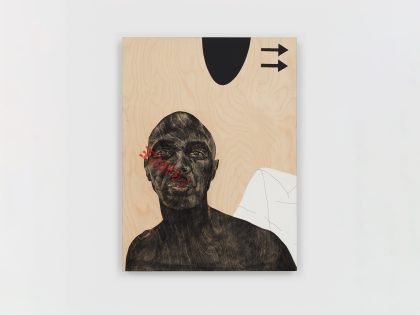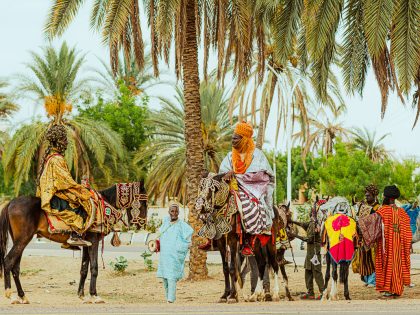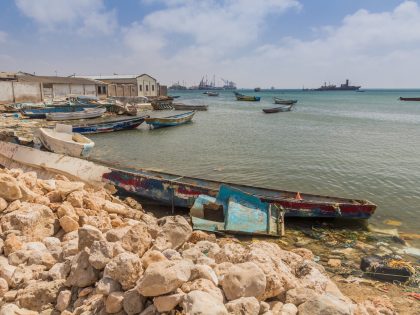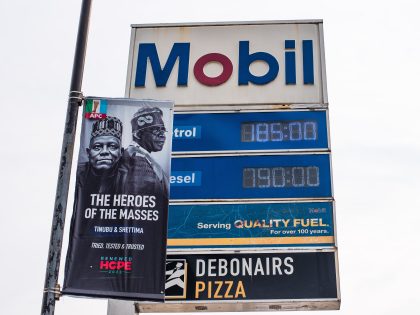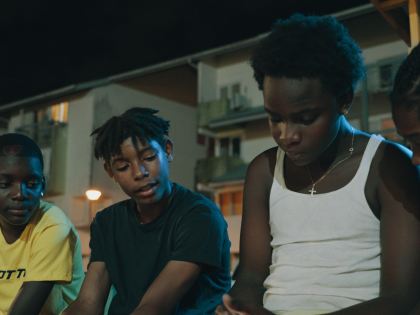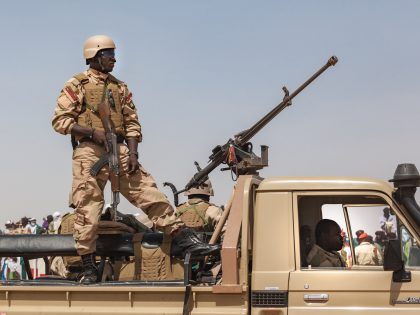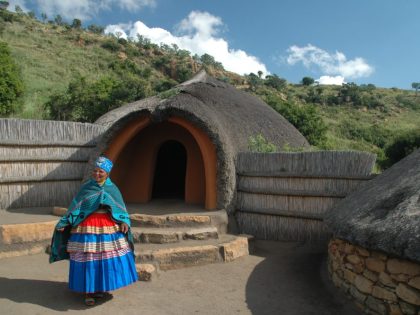The Ministry of Culture
In the wake of January 2011, art is not yet able to understand the exemplary demography of the Egyptian people.

Adel Abdin's “The king is dead, long live the king” (installation at Darb 1718 Contemporary Art and Culture Center, 2011).
The Egyptian people have voted in their first parliament since the downfall of Hosni Mubarak’s regime, but the revolution is being bitterly played out on Egypt’s streets. For many protesters, the struggle has only just begun. So long as the army occupies central Cairo, the revolution remains a question. Artist Nadine Hammam voices a popular mistrust: “Carter meeting with the Brotherhood, I don’t know what that is. … The army is state within a state. Like the Vatican in Rome.” Rereading Obama’s statements on Egypt from last year, there is a real critical problem to do with how we read the revolution, and this applies inside Egypt as well as internationally. As Linda Cleary, who runs the Arts Residency Cairo, points out: “a revolution requires a power shift and that hasn’t happened yet”.
Bidoun – the chichi New York-based Middle East arts magazine – published a limited-edition ‘Revolution’ issue (Summer 2011) with an ingenious header, collecting statements on the Arab Spring from the international media: ‘Egypt is not Libya’, ‘Zimbabwe is not Egypt, Honest’, ‘Iran is Not Egypt (Yet)’ and so on. In a recent post I quoted General Mukhtar el-Mallah: Egypt is not Tahrir. It seems, everyone has an opinion on what Egypt isn’t and which metaphors aren’t correct. Meetings such as that between Jimmy Carter and the Muslim Brotherhood encourage many to believe that covert deals – rather than public protests – have assured the transition of power between interest groups. This transition is, it seems, a problem of determining what the state of Egypt is. Since Woodrow Wilson’s ‘Fourteen Points’, self-determination has been at the foundation of ‘democratic’ military interventions. The state of Egypt has not been determined since the uprisings. But where can we find a trustworthy representation of the political consciousness of an entire country?
Representation is a real problem in Egypt, where peace and security cannot be assured until it is solved. Art is a domain in which these problems – of representation, determination, and expression, of the self and society – are being interrogated. At some point during the last twelve months, it seems, the role of art in Egyptian society became radically unclear. All of the Egyptian artists I have spoken to in the last month found it impossible to work during last year’s uprisings. If art made before 2011 seems prophetic (see, for example, Lara Baladi’s Borg el-Amal [‘Tower of Hope’]) its position since the beginning of the transition is far more problematic.
At the Picasso Gallery in Zamalek, a wealthy district in central Cairo, Helmi El Tonni’s paintings are challenging and infantile scenes of fat harlequins who tease the viewer with skeletal fish and the degraded Egyptian flag, smirking allusions to Mubarak’s dead regime. According to Ibrahim Abd El-Rahman, the gallery’s owner and a prodigious collector, many of these paintings have already been bought, not by foreign buyers but Egyptian businessmen. One of the positive outcomes of the revolution, he says, has been the empowerment of youth, who are starting to see art as an investment. Despite this, Negar Azimi (quoted in this excellent article by Ursula Lindsey) reflects on the difficult decisions facing art: “A survey of titles of works from recent exhibitions in Cairo reveals the following: ‘Freedom,’ ‘Drink Freedom,’ ‘Shadow of Freedom,’ ‘People Demand,’ ‘Man Crying’ and so on.” This is, she argues, “the sort of revolution-kitsch the market seeks. To be blandly political is in vogue and to be apolitical risks flirting with philistinism.”
Azimi (whose ArtForum article can be read here) argues that the Middle East is not ready for contemporary art; countries such as Egypt produce ‘timely mediocrities’, it is because changes in government must take place before celebrations of a country’s culture should happen. Azimi makes the important point that these celebrations can mask serious social problems, but I wonder whether art does not have an important role to play in those very changes. Art is one way of drawing a national culture into an international conversation, asking important questions about modernity, and bringing scrutiny and comparison to political realities. And praise is, after all, the best form of advice.
For the august collector Sherwet Shafei, the revolution has brought about a significant decline in custom at Safarkhan, the gallery she runs in Zamalek. I wonder whether this decline has been counterbalanced by an increased international interest in Egyptian art? She agrees: a recent exhibition in Frankfurt, To Egypt With Love, sold ninety percent of its work to foreign buyers. In this show, Hossam Hassan’s mixed-media work is exactly the kind of passionately political art Azimi describes: a revolutionary paint by numbers (see, for example, ‘Days to Remember’). I ask Shafei if the revolution has prompted new work. Very much so, and she names a young painter – Ahmed Kassim – whose exhibition will soon open at the gallery.
As ‘authentic’ experience often seems to be the prime material of art, but in Cairo the revolution seems an obstacle to artistic production. The painter Hossam Sakr – my host in Cairo – has found it difficult to make work since last January. He says it is because “we are still in the event.” For artists the revolution is a problem of experience. The revolution as event is, by definition, outside the norm. It is unclear how long it will take for the rules to change, for reality to be reimposed, and for art to resurrect the exception as an experience – and attempt to inhabit it. These abstract problems are practical obstacles for artists in Egypt. I realise I have been hoping to find some quietly powerful subjective document of the times, a contemporary correspondent to Arthur Rimbaud, who elaborated his revolutionary poetic project during the fated Paris Commune. This search was too hasty. I’m told to wait until 2013. See what has happened by then.
Art and protest were united when Tahrir Square first became a theatre for self-expression. William Wells, director of Townhouse Gallery, mentions the spontanous spontaneous humour of protesters who, when they heard the regime claim they were serving foreign agendas, produced models of books – which read ‘US Agenda’, ‘Israeli Agenda’. Moataz Nasr, artist and director of Dar 17 18 contemporary art and cultural centre, mentions the creativity of the protesters who made “performances with their body”. Nasr mentions one boy “writing on his body his phone number … so that his father will be called [if he is killed]”. Given this creativity, when protest encompasses so much that it has – or might aim for – art has been forced to ask itself some difficult questions.
When the protests started to routinely meet violence, some artists started to withdraw to their studios, some took residencies abroad, some were killed, some injured, and some remain. Those who stayed have often been subjected to a new kind of scrutiny. Conversations about Egyptian nationality have become increasingly exclusive. I’ve heard stories, at protests, of people being asked are you really Egyptian? This xenophobia has been exacerbated by the army’s recent call for citizens to arrest those working against the revolution.
The counterpart to this is the radical Islamic critique of art, provided by the Egyptian cleric Mahmoud Amer: “I’m talking in general about the artists who held that demonstration or strike. What is this art of yours? The art of lesbians? The art of prostitutes? What reasonable Egyptian would say that it’s okay? Hold a referendum.” This archetype, the ‘reasonable Egyptian’, has become a critical problem for the revolution.
Art institutions in Cairo are clearly trying to respond to these problems of representation. At the beginning of April a coalition of independent galleries presented the first al-Fann Midan (‘Art is a Square’) event in Abdeen Square (as well as five other cities: Alexandria, Asyat, Suez, Minya and Port Said). Organisations such as Moisireen were set up to collect the revolution’s raw data. This activity has recently led to the Kazeboon (‘Liars’) project, screening footage of military violence against protesters set up to combat the SCAF media campaign to represent the protesters as thugs. Townhouse is publishing some of the data collected through interviews with protesters. Making the data of the revolution available to the artists of the future is an activity which will no doubt prove highly valuable.
First established in downtown Cairo in 1998 by Canadian-born Wells, Townhouse has changed everything in Egyptian contemporary art, and become one of the most important institutions for contemporary art in the region. Artist Nadine Hammam says “there was no contemporary art scene in Cairo before William.” The gallery has been carefully negotiating its position through the tumultuous past twelve months. Wells spoke to Bidoun about some recent problems:
“The street was completely divided between the pro-Mubarak and the protestors. It was split right down the middle. … People that I knew really well, and I had worked with for years. When the violence on the street started escalating and I needed a way to leave the building safely, they didn’t want to help me get out.”
Since last year’s uprisings, the gallery has been engaging with the multiplicities of political agency, on a local and national level. Since the beginning of December the show occupying the exhibition space at Townhouse – blankly called The Politics of Representation – presents different cartographies of Egyptian politics. Outside the outreach office, a diagram maps out the gallery’s functions, its links to NGOs, embassies, cultural organisations, and the coffee shops of nearby streets.
Townhouse hosted events which curated protester’s testimonies: the Tahrir Monologues, Lessons in Revolting, open mic nights, realising Wells’s ambition to turn the gallery into a truly multi-disciplinary space which responds to the needs of the community. Writing three decades before the French Revolution, Jean-Jacques Rousseau proposed a radical festival: a spectacle without “anything to see”, a theatre where the audience become the actors. Townhouse seems to have reached similar conclusions. Wells told me “Before the revolution there was a silent audience. Now they’re saying ‘We’re not going to sit in the coffee shop, we’re players now.’”
If the protests of 2011 involved the reclamation of the theatre of political expression by its audience, this radical situation was short-lived: there was an agreement early on in Tahrir that there would be no stages, no microphones. The Brotherhood were the first party to erect a stage, and almost immediately everyone else had erected their own. The history of factionalism is being played out in Egypt. Public meetings such as that between Carter and the Muslim Brotherhood illustrate how the erecting of a stage can be the first step towards construction of a new political hierarchy.
Last year, Townhouse set up a “wannabe photoshoot”, using a life-sized image of Tahrir Square as a backdrop, people could pose for photographs which made it look as though they were in the right place at the right time (and this [and this] seems to have become a popular site for a dubious pilgrimage to democracy). Another project the gallery supported involved a similar détournement, in which artist Ayman Ramadan produced a street sign quoting Barack Obama’s response to the uprising: ‘The Situation is Fluid.’ (The accompanying Arabic reads ‘the situation is not fluid’.) I wondered when I heard this: what makes Obama’s statement feel so wrong? The uprising clearly had, at many points, fluidities. But (as with Berlusconi’s words quoted in the last post) the question is not whether the truism is true, but how it is used. What cowardice it authorises. And what opportunism.
Debate around the recent elections highlights an important difference between populism and democracy. Electoral victories by candidates sponsored by the Muslim Brotherhood and Salafi groups seem to have betrayed the democracy fought and won by protesters in Tahrir Square. The revolution has been forced to forget its fluidities, and protesters are expected not only to come up with the achievable goals of a manifesto, but to run a successful campaign. This picture is hopelessly simplistic. It is clear that whatever has changed in Egypt – and whatever the [Army’s] army’s role in Mubarak’s downfall – the global community witnessed a real dedication of bodies to collective goals.
I was struck by how aware the Egyptians I met in Cairo were that they had inspired protests throughout the world. Moataz Nasr’s recent exhibition at the Selma Feriani Gallery in London was meant to be accompanied by a large calligraphic maze in nearby Hanover Square, ‘The People Want the Fall of the Exhibition.’
The maze was rejected by the local council on the grounds that it was too political a statement, too early. It is fitting that art made in Egypt should be pushing the boundaries of political utterance beyond the borders of Egypt.
The Occupy movements have signalled their identification with the Egyptian revolution, and this is not just solidarity (or optimistic thinking that their occupations might be so effective) but an identification of bodies with bodies. The British poet J.H. Prynne has described radical occupation as
“a kind of trespass, to stream into controlled spaces and just overflow them, not by reasoned argument but simply by shared presence: demography! Thus the legal formats of punitive exclusion are also challenged, not by violence but simply by spillage of peoples in large numbers and by acts of individual self-positioning.” (The rest can be found here.)
It is the exemplary demography of the Egyptian people – overflowing the measures of control and challenging violent monopolies – which art is not yet able to understand. The courage, industry and imagination exhibited in Egypt in the last year mean this surely will not remain the case for long.













